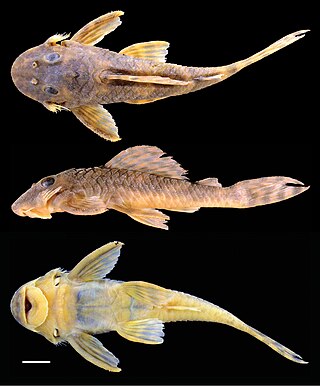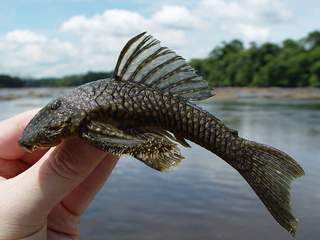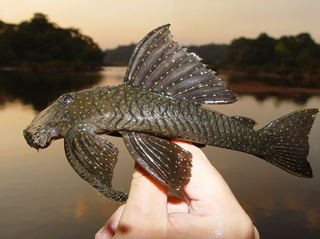
Paracentropogon longispinis, the wispy waspfish, sailfin waspfish, whiteface waspfish or whiteface roguefish, is a species of marine ray-finned fish, a waspfish belonging to the subfamily Tetraroginae, which is classified as part of the family Scorpaenidae, the scorpionfishes and their relatives. It is found in the central Indo-West Pacific. It is the type species of the genus Paracentropogon.

Paracentropogon is a genus of ray-finned fishes, waspfishes belonging to the subfamily Tetraroginae, which is classified as part of the family Scorpaenidae, the scorpionfishes and their relatives, These fish are found in the Indian Ocean and western Pacific Ocean.

Peckoltia vittata is a species of catfish belonging to the subfamily Hypostominae of the family Loricariidae.
Peckoltia multispinis, commonly known as the bristlemouth catfish, is a species of small freshwater fish in the genus Peckoltia of the catfish family Loricariidae. It has the L-number L049. It is possibly a junior synonym for Peckoltia vittata. However, the online Encyclopedia of Life lists this fish as Lasiancistrus multispinis. The California Academy of Sciences lists Peckoltia multispinis as the currently correct name. This species is not to be confused with the valid but unrelated species Ancistrus multispinis, and although A. multispinis has been used as a name for both this species and the one it is currently used for, A. multispinis was initially described as a member of the now-invalid genus Xenocara and was classified under that genus when this species was first described as a member of Ancistrus. Because of this, Ancistrus multispinis is a valid name, but not one that should be used for P. multispinis.
Peckoltichthys bachi is a species of armored catfish and the only member of its genus. This species is found throughout the upper Amazon River and its tributaries in Brazil, Colombia, Ecuador, and Peru. The species reaches 14 cm SL. FishBase lists this species as a member of Peckoltia.
Pseudoqolus koko is a species of catfish in the family Loricariidae and the only species in the genus Pseudoqolus. It is a freshwater fish native to South America, where it occurs in the Maroni basin. It is usually found on or near stony substrates in the main river channel at a depth of around 2 m. The species has been collected alongside multiple other loricariid species, including Hemiancistrus medians, Peckoltia otali, Pseudancistrus barbatus, Harttia guianensis, Loricaria cataphracta, and Rineloricaria stewarti. It is noted that the gut contents of one specimen of this species contained primarily spicules and sponge fragments, indicating that it may feed on freshwater sponges. The species reaches 9 cm SL.
Peckoltia capitulata is a species of catfish in the family Loricariidae. It is native to South America, where it occurs in the Approuague River in French Guiana. It was initially collected from an area of the river with a swift, strong current that was noted to be unusually turbid at the time of collection due to illegal gold mining in the area. The species reaches 7.6 cm SL. Its specific epithet, capitulata, is derived from Latin and reportedly refers to the characteristically small head of the species.

Peckoltia ephippiata is a species of catfish in the family Loricariidae. It is a freshwater fish native to South America, where it is known from the Leitão River, which is part of the Madeira River drainage in the state of Rôndonia in Brazil. The species reaches 10.2 cm SL.
Peckoltia furcata is a species of catfish in the family Loricariidae. It is native to South America, where it occurs in the Ucayali River basin in Peru. The species reaches 9.2 cm SL. While not common in the trade, it is sometimes kept in aquaria, although it has no associated L-number or widely used common name.

Peckoltia lujani is a species of catfish in the family Loricariidae. It is native to South America, where it occurs in the Orinoco and Meta River basins in Venezuela and Colombia. The species reaches 7.5 cm SL.
Peckoltia oligospila is a species of catfish in the family Loricariidae. It is a freshwater fish native to South America, where it occurs in the lower Amazon River basin in Brazil. The species reaches 10.5 cm SL. It appears in the aquarium trade, where it is typically referred to either by its associated L-number, which is L-006, or as the brown-dot peckoltia.
Pseudancistrus genisetiger is a species of catfish in the family Loricariidae. It is native to South America, where it occurs in the Jaguaribe River basin in Brazil. The species reaches 10.3 cm SL.
Pseudancistrus guentheri is a species of catfish in the family Loricariidae. It is native to South America, where it was initially collected from an unknown locality in Guyana, although it has subsequently been reported from the confluence of the Mazaruni River and the Cuyuni River near the village of Kartabo. The species reaches 12 cm (4.7 in) in length.
Pseudancistrus orinoco is a species of catfish in the family Loricariidae. It is native to South America, where it occurs in the Orinoco basin. The species reaches 10 cm in total length.
Pseudancistrus yekuana is a species of catfish in the family Loricariidae.
Pseudancistrus pectegenitor is a species of catfish in the family Loricariidae. It is native to South America, where it occurs in the main channel of the Orinoco near the mouth of the Ventuari River, as well as in the Casiquiare. The species is usually found in areas with flowing water near large rocky outcrops. It reaches 24.2 cm SL.
'Pseudancistrus' megacephalus is a species of catfish in the family Loricariidae. It is of uncertain and disputed classification.
Pseudancistrus papariae is a species of catfish in the family Loricariidae. It is native to South America, where it occurs in Lake Papari and the Jaguaribe River basin in Brazil. The species reaches 15.3 cm SL.

Guyanancistrus longispinis is a species of catfish in the family Loricariidae that is of disputed classification. It is native to South America, where it occurs in the Oyapock basin in French Guiana. It is typically seen in shallow rapids with rocky substrates and moderate levels of illumination. It is known to occur alongside the species Guyanancistrus brevispinis, Harttia fowleri, and Crenicichla ternetzi, as well as members of the genus Ancistrus. The species reaches 10.4 cm in standard length and may be a facultative air-breather.

Guyanancistrus niger is a species of catfish in the family Loricariidae that is of disputed classification. It is native to South America, where it occurs in the Oyapock basin in French Guiana. Though reportedly uncommon, it is typically seen in rapids where the species Pseudancistrus barbatus is also present, although the ecological relationship between the two is not known. The species reaches 15.9 cm in standard length, although it has been reported to reach 25.4 cm, and it may be a facultative air-breather.






